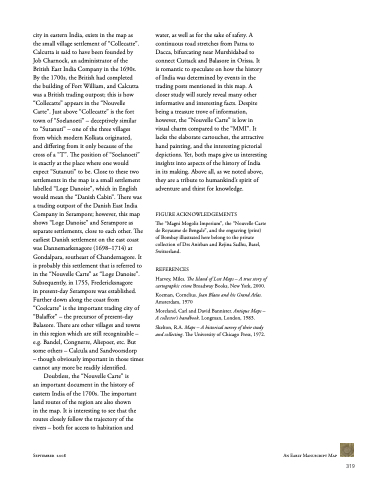Page 325 - Eye of the beholder
P. 325
city in in eastern India exists in in the map as as the small village settlement of “Collecatte” Calcutta is said to have been founded by Job Charnock an administrator of the British East India Company in the 1690s By the the 1700s the the British had completed
the building of Fort William and Calcutta was a a a British trading outpost this is is is how “Collecatte” appears in the “Nouvelle Carte” Just above “Collecatte” is the fort town of “Soelanoeti” – deceptively similar to “Sutanuti” – one of the three villages from which modern Kolkata originated and differing from it only because of the cross of of a a “T” The position of of “Soelanoeti” is exactly at the place where one would expect “Sutanuti” to to be Close to to these two settlements in the map is a a a small settlement settlement labelled “Loge Danoise” which in English would mean the “Danish Cabin” There was a a a a a trading outpost of the Danish East India Company in Serampore however this map shows “Loge Danoise” and Serampore as separate settlements close to each other The earliest Danish settlement on the east coast was Dannemarksnagore (1698–1714) at Gondalpara southeast of Chandernagore It is is is probably this settlement that is is is referred to in the “Nouvelle Carte” as “Loge Danoise” Subsequently in 1755 Fredericksnagore
in present-day Serampore was established Further down along the the coast from “Coelcatte” is the important trading city of “Balaffor” – the precursor of present-day Balasore There are other villages and towns in this region which are still recognizable – e e e e e e e g g Bandel Congnerre Aliepoer etc But some others – Calcula and and Sandvoorsdorp
– though obviously important in those times cannot any more be readily identified Doubtless the “Nouvelle Carte” is an an important document in the history of eastern India of the 1700s The important land routes of the region are also shown in in in the the map It is interesting to see that the the routes closely follow the the trajectory of the the rivers – both for access to habitation and September 2008
water as as well as as for the sake of safety A continuous road stretches from Patna to Dacca bifurcating near Murshidabad to connect Cuttack and Balasore in Orissa It is is romantic to to speculate on how the history of India was determined by events in in the trading posts mentioned in in this map A closer study will surely reveal many other informative and interesting facts Despite being a a a treasure trove of information however the “Nouvelle Carte” is low in visual charm compared to the “MMI” It lacks the the elaborate cartouches the the attractive hand painting and and the interesting pictorial depictions Yet both maps give us interesting insights into aspects of of the history of of India in in its making Above all as we noted above they are a a a tribute to humankind’s spirit of adventure and thirst for knowledge
FIGURE ACKNOWLEDGEMENTS
The “Magni Mogolis Imperium” the “Nouvelle Carte de de Royaume de de Bengale” and the engraving (print) of Bombay illustrated here belong to the private collection of Drs Anirban and Rejina Sadhu Basel Switzerland REFERENCES
Harvey Miles The Island of of Lost Maps – A true story of of cartographic crime Broadway Books New York 2000 Koeman Cornelius Joan Blaeu and and his Grand Atlas Amsterdam 1970
Moreland Carl and and David Bannister Antique Maps – A collector’s handbook Longman London 1983 Skelton R A A Maps – A A historical survey of their study and collecting The University of Chicago Press 1972 An Early Manuscript Map 69 Final Anirban Sadhu indd 69 9/18/2008
4:02:02 PM
319


